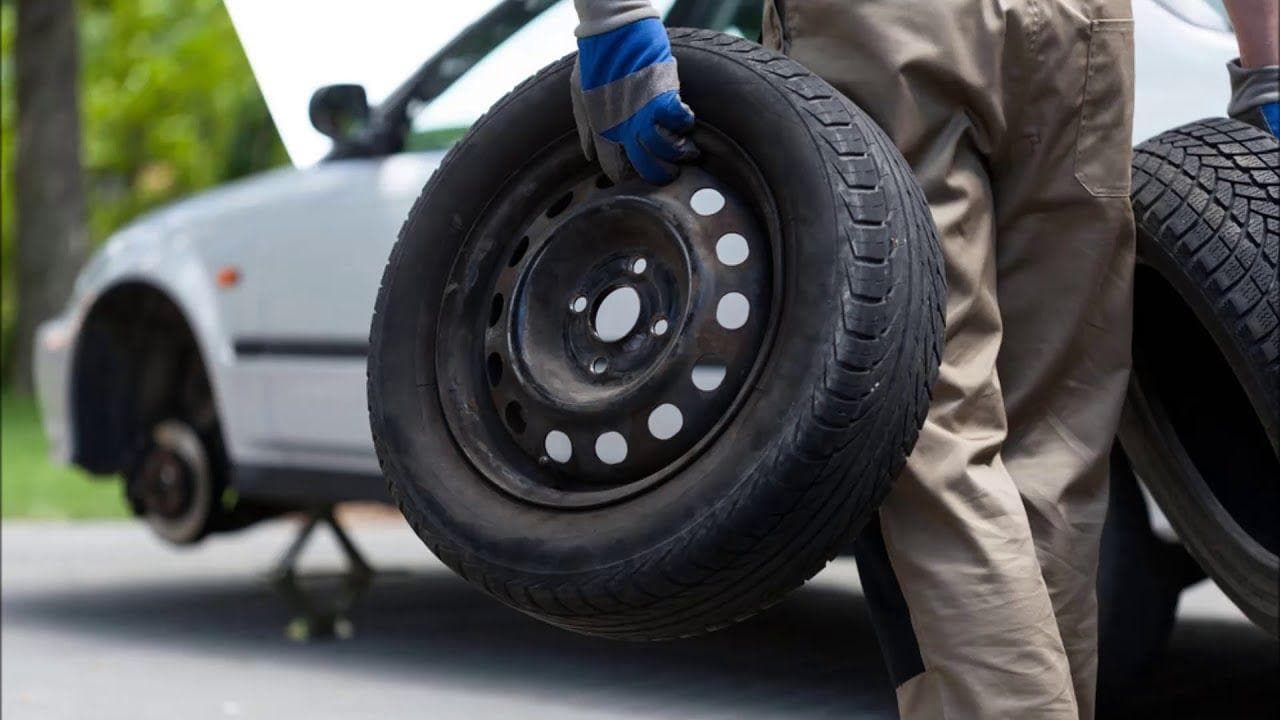Tire Solution: Proven Methods for Optimal Tire Upkeep and Care
From ensuring appropriate tire pressure to routine rotation and placement, there are tried and tested approaches that can significantly extend the lifespan of your tires and enhance general driving experience. Allow's dive into the globe of tire solution and discover the tricks to maintaining your tires in top-notch form for the long haul - Mobile Tire Repair Las Vegas.
Value of Tire Stress
Correct tire stress is a vital element in ensuring ideal automobile efficiency and safety when traveling. Maintaining the suggested tire stress levels provided by the producer uses many benefits. Sufficient tire pressure promotes better fuel effectiveness, as under-inflated tires can lead to boosted rolling resistance, triggering the engine to work harder and take in more fuel. Correct tire pressure guarantees even step wear, improving tire long life and conserving money in the lengthy run by postponing the need for early replacements. Additionally, appropriately pumped up tires contribute to boosted handling and braking capabilities, vital for risk-free driving in various roadway conditions. Over-inflated tires, on the various other hand, can result in lowered grip and a harsher ride. On the other hand, under-inflated tires are vulnerable to getting too hot, which can lead to accidents and blowouts. Regularly adjusting and checking tire stress, especially in the past long journeys, is a basic yet effective method to improve automobile efficiency, prolong tire life-span, and prioritize security on the roadway.
Tire Rotation Guidelines
When thinking about tire turning standards, it is essential to understand the importance of this upkeep job in maximizing tire lifespan and keeping ideal car performance. Tire rotation entails altering the position of each tire on a car to guarantee also tread wear. Front tires tend to wear more quickly than back tires because of steering forces, making normal turning essential for balanced wear patterns. The advised turning pattern differs depending on whether a lorry is front-wheel, rear-wheel, all-wheel, or four-wheel drive. Typically, tires should be rotated every 5,000 to 7,500 miles, or as advised in the lorry handbook. Ignoring tire turning can result in uneven wear, influencing handling, traction, and possibly compromising vehicle safety and security. By adhering to correct rotation standards, chauffeurs can expand the life of their tires, improve gas efficiency, and boost overall driving experience. Normal rotation is a basic yet effective upkeep method that adds considerably to tire long life and car efficiency.

Benefits of Wheel Positioning
Ensuring correct wheel positioning after tire rotation is critical for maintaining balanced wear patterns and optimizing car efficiency. Wheel positioning describes the change of the angles of the wheels to the producer's specs. Among the essential benefits of wheel placement is enhanced managing and steering feedback. When the wheels are appropriately aligned, it minimizes steering initiative, guaranteeing a smoother and more controlled driving experience. Furthermore, correct wheel positioning helps to extend the lifespan of your tires. Misaligned wheels can create uneven advice tire wear, bring about premature tire replacement and boosted upkeep expenses.

Tire Footstep Depth Examine
Performing a normal examination of tire step depth is essential for preserving safe driving problems and lengthening the life expectancy of your tires. Uneven step wear can indicate concerns with tire stress, positioning, or suspension, highlighting the importance of normal tread deepness checks. By including tire step deepness checks into your regular maintenance timetable, you can drive check here with confidence knowing that your tires are in leading condition.
Seasonal Tire Examination
A detailed evaluation of tire condition tailored additional hints to specific climate conditions is critical for preserving ideal efficiency and safety throughout the year. Seasonal tire examination is a fundamental element of tire maintenance that makes certain tires prepare to encounter the challenges postured by various weather. To prepare for winter, it is important to examine the tire pressure routinely as chilly temperature levels can cause tire pressure to drop. Checking tire step depth is also crucial to make certain sufficient grip on snow and frozen roadways. Additionally, looking for indications of deterioration, such as lumps or cracks, can help prevent possible tire failings. As the seasons change, it is necessary to assess tire problem and make any kind of necessary adjustments to guarantee risk-free driving. By conducting routine seasonal tire assessments, vehicle drivers can lengthen tire life-span, boost gas effectiveness, and most significantly, make sure a safe and secure driving experience in differing weather - Mobile Tire Change Las Vegas.
Conclusion
In final thought, maintaining correct tire pressure, revolving tires on a regular basis, aligning wheels correctly, checking walk deepness, and carrying out seasonal examinations are important techniques for optimal tire treatment. By following these verified approaches, vehicle drivers can ensure their tires last much longer, perform much better, and add to total lorry security. It is vital to prioritize tire maintenance to avoid crashes, boost fuel effectiveness, and lengthen the life-span of tires.
Sufficient tire stress promotes much better gas performance, as under-inflated tires can lead to enhanced rolling resistance, triggering the engine to function tougher and eat more fuel.When thinking about tire turning guidelines, it is essential to comprehend the value of this upkeep job in maximizing tire life expectancy and preserving ideal automobile efficiency. Seasonal tire assessment is a basic facet of tire upkeep that makes sure tires are all set to encounter the obstacles postured by various weather conditions. By conducting routine seasonal tire inspections, drivers can extend tire lifespan, enhance gas performance, and most significantly, make sure a safe driving experience in differing climate problems.
In final thought, preserving proper tire stress, rotating tires routinely, aligning wheels appropriately, keeping an eye on walk deepness, and conducting seasonal examinations are necessary methods for optimal tire treatment.